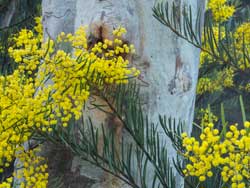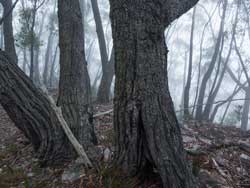These forests are the flammable matrix that carries fire across the landscape.
Dry sclerophyll forests occur across almost 85% of the Greater Blue Mountains. They dominate the exposed, low-nutrient soils of the vast sandstone plateaux and the valley slopes of the softer Permian geological deposits.
Nine classes of dry sclerophyll forest occur in the Greater Blue Mountains; they vary greatly in composition, including in their canopy eucalypts, reflecting differences in the topography, soil and climate in the areas in which they are found.
The seven classes with predominantly shrubby understoreys are found on silica-rich sandstone-derived soils, while a further two classes with a conspicuous presence of grasses and herbs in the understorey, in addition to shrubs, are found on marginally better soils.
- Sydney Hinterland Dry Sclerophyll Forests
- Sydney Coastal Dry Sclerophyll Forests and Sydney Montane Dry Sclerophyll Forests
- Sydney Sand Flats Dry Sclerophyll Forests
- South East Dry Sclerophyll Forests and Southern Tableland Dry Sclerophyll Forests
- Western Slopes Dry Sclerophyll Forests
- Central Gorge Dry Sclerophyll Forests
- Hunter-Macleay Dry Sclerophyll Forests
Sydney Hinterland Dry Sclerophyll Forests
 Sydney Hinterland Dry Sclerophyll Forest,
Sydney Hinterland Dry Sclerophyll Forest,
Capertee River Gorge,
with Inland Scribbly Gum (Eucalyptus rossii) and Rough-barked Apple (Angophora floribunda). (Ian Brown)
These forests dominate the sandstone slopes and ridges at low- to mid-elevations in the Greater Blue Mountains, in the coastal rainshadow (which generally receives less than 1000 mm per year) from northern Wollemi and Yengo through to Nattai National Park.
Tree species that are particularly distinctive in these forests are Yellow Bloodwood (Corymbia eximia), Scaly Bark (Eucalyptus squamosa) and Narrow-leaved Apple (Angophora bakeri), which occur alongside numerous other common sandstone eucalypts.
Sydney Coastal Dry Sclerophyll Forests and Sydney Montane Dry Sclerophyll Forests
 Sydney Coastal Dry Sclerophyll Forest,
Sydney Coastal Dry Sclerophyll Forest,
Wollemi National Park,
dominated by Smooth-barked Apple (Angophora costata). (Ian Brown)
The coastal forests are uncommon in the Greater Blue Mountains, being found only on the eastern fringe of Yengo National Park: they are more extensive nearer the coast.
They are characterised by Smooth-barked Apple (Angophora costata), Red Bloodwood (Corymbia gummifera) and Broad-leaved Scribbly Gum (Eucalyptus haemastoma), among other eucalypts, over a diverse understorey of sclerophyllous shrubs that are often taller and denser than in other dry sclerophyll forests in the region.
The montane class is more extensive in the Greater Blue Mountains, occurring across large areas of the higher plateaux, generally between 750 and 1200 m above sea level, including around the towns of the upper Blue Mountains and on the Newnes Plateau.
The striking forests dominated by Blue Mountains Ash (Eucalyptus oreades), which occur in sheltered locations and on the precipices of the escarpment, are included in this montane class.
Other characteristic species in these forests are the peppermints (Eucalyptus piperita, E. dives and E. radiata), Silvertop Ash (Eucalyptus sieberi) and stringybarks (including Eucalyptus blaxlandii).
Sydney Sand Flats Dry Sclerophyll Forests
Sydney Sand Flats Dry Sclerophyll Forests also occur on nutrient poor, sandy soils, but are highly restricted within the Greater Blue Mountains where they are found in only one location – the alluvial white sand deposits at Mellong in the upper reaches of the Macdonald River.
South East Dry Sclerophyll Forests and Southern Tableland Dry Sclerophyll Forests
 South East Dry Sclerophyll Forest
South East Dry Sclerophyll Forest
of Silvertop Ash (Eucalyptus sieberi),
Kanangra-Boyd National Park. (Ian Brown)
In the high-altitude, south-western parts of the World Heritage Area, the South East Dry Sclerophyll Forests and Southern Tableland Dry Sclerophyll Forests are the predominant vegetation classes.
Silvertop Ash (Eucalyptus sieberi), Broad-leaved Peppermint (Eucalyptus dives) and Blaxland’s Stringybark (Eucalyptus blaxlandii) often dominate the former, while Red Stringybark (Eucalyptus macrorhyncha), Scribbly Gum (Eucalyptus rossii) and Mountain Gum (Eucalyptus dalrympleana subsp. dalrympleana) may dominate the latter.
Western Slopes Dry Sclerophyll Forests
 Sydney Montane Dry Sclerophyll Forest,
Sydney Montane Dry Sclerophyll Forest,
Newnes Plateau,
with Blue Mountains Ash (Eucalyptus oreades) in foreground and flowering Sunshine Wattle (Acacia terminalis). (Ian Brown)
Their main occurrence is further north-west.
Central Gorge Dry Sclerophyll Forests
 Central Gorge Dry Sclerophyll Forest,
Central Gorge Dry Sclerophyll Forest,
with Forest Red Gum (Eucalyptus tereticornis),
on the slopes above the Kowmung River - and Eastern Riverine Forest bordering the river. (Ian Brown)
They are often characterised by Forest Red Gum (Eucalyptus tereticornis), Yellow Box (Eucalyptus melliodora) and Narrow-leaved Ironbark (Eucalyptus crebra).
Hunter-Macleay Dry Sclerophyll Forests
The Hunter-Macleay Dry Sclerophyll Forests are highly restricted, occurring in rain shadow areas on the footslopes of the ranges bordering the Hunter Valley in north-east Wollemi and Yengo.
Typical trees are Spotted Gum (Corymbia maculata), Narrow-leaved Ironbark (Eucalyptus crebra) and Turpentine (Syncarpia glomulifera).
Threatened Ecological Communities of dry sclerophyll forests
Hunter Valley Footslopes Slaty Gum Woodland (vulnerable), a type of Western Slopes Dry Sclerophyll Forest, may occur on the northern fringes of Wollemi National Park.
Dry Sclerophyll Forests Flora
 Inland Scribbly Gum (Eucalyptus rossii) and
Inland Scribbly Gum (Eucalyptus rossii) andHamilton's Wattle (Acacia hamiltoniana)
photo by: Ian Brown
Two scribbly gum species are widespread in dry Blue Mountains forests: E. sclerophylla in the east and central, with E. rossii taking over in the west.
 Green Spider Flower (Grevillea mucronulata)
Green Spider Flower (Grevillea mucronulata)
photo by: Alan Page
The flower is around 60mm across.
 NSW Waratah (Telopea speciosissima)
NSW Waratah (Telopea speciosissima)
photo by: Dianne Page
More Dry Sclerophyll Forests Landscapes
 Silvertop Ash (Eucalyptus sieberi),
Silvertop Ash (Eucalyptus sieberi),Kanangra-Boyd National Park
photo by: Ian Brown
 Sydney Hinterland Dry Sclerophyll Forest,
Sydney Hinterland Dry Sclerophyll Forest,Wollemi National Park
photo by: Ian Brown
 Western Slopes Dry Sclerophyll Forest,
Western Slopes Dry Sclerophyll Forest,Capertee Gorge, Wollemi National Park
photo by: Ian Brown

